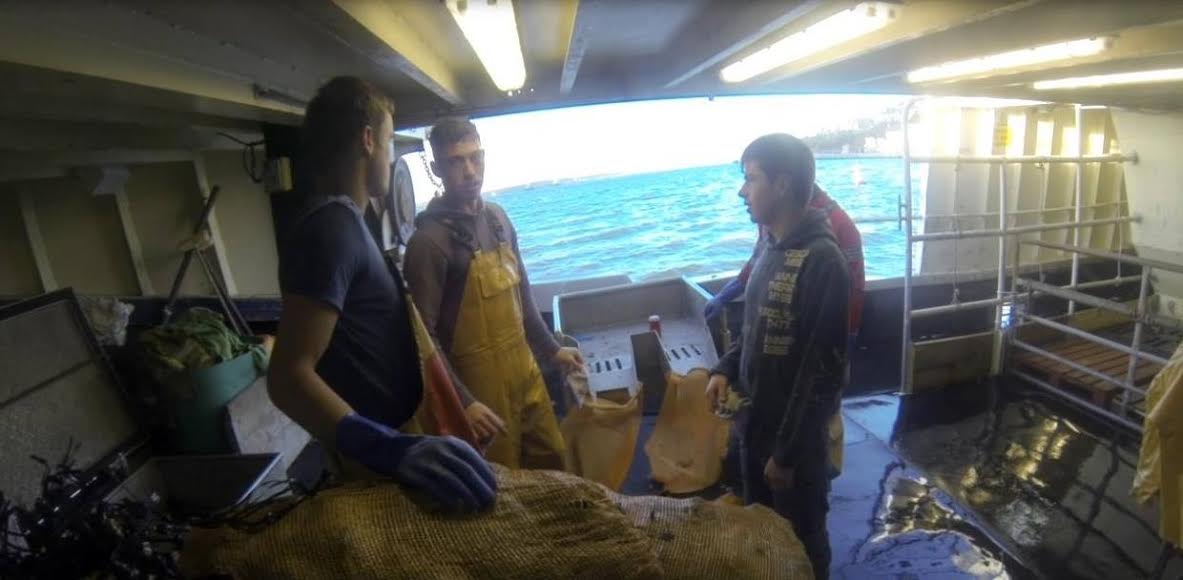News
Sixteen year old skipper’s heart-break over lost trawler


EXCLUSIVE by Matthew Bearne
THE PEMBROKESHIRE HERALD has spoken exclusively to the skipper of the a Milford-registered fishing boat, who was dramatically rescued along with the rest of his crew last week.
The Cesca, a 16 metre trawler,sank off north Wales on Thursday (Feb 12).
The vessel ran into difficulties off The Llyn Peninsula, but despite the best efforts of the crew and coastguard, she finally sank at around 2330HRS. The four-man crew, who had abandoned ship, was airlifted off the life-raft in difficult conditions. After a check-up in Bangor hospital, they were released the same night.
Sixteen-year-old Jake Bowman-Davies, the youngest fully-qualified skipper in the British Isles, talked of his efforts to save the boat after she started taking on water on passage from Milford Haven to grounds off Conwy.
He told The Herald: “At ten o’ clock the bilge pumps suddenly started running flat out. I put the auxiliary pumps on and called the coastguard, requesting assistance and pumps. They told me to report the boat’s bearing and position every ten minutes, which we did.”
Skipper Bowman-Davies added: “I aimed the boat at land, so I could beach her as a last resort. We started taking on water fifteen miles out, and we got within four miles of the coast before the helicopter turned up with the pumps. They asked us to alter our course to 210 degrees so they could lower the equipment down to us.”

Sank: The Cesca
“By this point the engine had failed due to the leak, and the boat had reached the point of no recovery, so we told the helicopter crew that we were abandoning ship.’
Jake described jumping off the boat in the dark in force 8 winds as ‘the scariest moment of my life”
“It broke my heart to leave the Cesca. She had been in the family since I was ten. I did everything I could to save her, but at the end of the day the safety of the crew comes first,” he added.
The owner of the Cesca, Jake’s father Timothy Bowman-Davies, praised the Seafish Training scheme. Both Jake and leading hand Nathan Edmundson (23) hold their 16.5 metre skippers’ tickets, and the other crew, Luke Lane and twenty-year-old Dai Crofts, have completed all their mandatory certification.
“What they learned on the Sea Survival Course definitely contributed to their safe recovery. Without this training the outcome could have been disastrous,’ he said, before thanking the rescue services for their ‘speedy response and professionalism.’
‘I’m so relieved to have my son and crew home safely. Without these institutions in place seamen of the United Kingdom would run a far greater risk,” he added.
The cause of the the Cesca’s sinking remains unknown. However, Jake believes that the boat hit a submerged object in the water. “The helicopter crew told me that they could see something sticking out of the side of the boat. However, I don’t think we’ll ever know exactly what happened,” he said.
News
Welsh pensioners to receive state pension increase amidst mixed reactions

STARTING this month, over 600,000 pensioners across Wales will see their State Pensions rise by up to £470 annually, following the UK Government’s adherence to the ‘triple lock’ policy. This policy ensures that pensions increase each year by the highest of average earnings growth, inflation, or a minimum of 2.5%.
Government’s Position
The UK Government has emphasized its commitment to supporting pensioners through the triple lock. In a recent statement, it was noted that this commitment would result in the State Pension increasing by up to £1,900 over the course of the current Parliament.
Opposition and Think Tank Critiques
However, the policy has faced criticism from various quarters. The Liberal Democrats have raised concerns about the real impact of the pension increase, pointing out that due to the freezing of income tax thresholds, a significant portion of the pension rise could be offset by increased tax liabilities. They estimate that a typical basic rate tax-paying pensioner might see 77% of the pension increase negated by these tax measures.
Additionally, the Institute for Fiscal Studies (IFS) has questioned the sustainability of the triple lock mechanism. They argue that while the policy aims to protect pensioners’ incomes, it may not be the most efficient approach and could lead to unpredictable fiscal burdens.
Pensions Minister’s Stance
Torsten Bell, the newly appointed Pensions Minister, has previously described the triple lock as “rubbish” and advocated for its replacement with a system that aligns state pension increases with benefits for jobseekers and the long-term sick. Despite his past remarks, recent reports indicate that he is now “fully committed” to maintaining the triple lock.
Economic Implications
Financial experts have also highlighted potential unintended consequences of the pension increase. The freezing of personal tax allowances means that some pensioners may find themselves pushed into higher tax brackets, thereby reducing the net benefit of the pension rise. This situation underscores the complex interplay between pension policies and tax regulations.
In summary, while the increase in State Pensions is a welcome development for many Welsh pensioners, it has sparked a broader debate about the effectiveness and sustainability of the triple lock policy, as well as its interaction with the broader tax system.
Crime
Over 120 Carmarthenshire people identified as ‘money mules’ in fraud probe

More than 120 people in Carmarthenshire, mostly living in the Llanelli area have handed over their personal bank details to criminals involved in money laundering in exchange for financial gifts.
Economic Crime Team officers from Dyfed-Powys Police identified the individuals as part of an ongoing criminal investigation and issued notices advising them to stop the activity immediately or face prosecution.
Throughout February, the team visited people who had been linked with a suspected fraudster, as part of Operation Henhouse – a month-long nationwide clampdown on fraud offences.
On speaking to those involved, officers learned how the individuals opened online bank accounts using their personal information and identification and gave their account login details to criminals in return for cash, who then used their bank accounts to launder money obtained through crime.
The team offered safeguarding advice and warned them about the dangers of opening bank accounts to be used by someone else for criminal activity.
Many were unaware of the implications of what they had done and thought it was an easy way to make some money. Some were given financial gifts ranging from £50 to £200, while others were promised money but did not receive it.
Dyfed-Powys Police Fraud Investigator Sian Stevens said: “Through intelligence, we were made aware of a fraudster who recruited a number of people in the Llanelli area to open bank accounts, which were then subsequently used for money laundering purposes.
“The Economic Crime Team visited over 120 individuals in February to explain that they had been used as a money mule – this is someone, who has allowed their bank account to be used to send criminal money. We issued them with cease and desist notice to interrupt any further fraud by making sure they were aware what they were doing was a criminal activity.
“Many of the people were linked to each other. Some were family members or in the same friendship groups, ranging from young adults to pensioners. The accounts had been opened as a direct or indirect interaction with the fraudster.
“For example, there were some instances where an individual opened a bank account after contact with the fraudster and then went on to tell their friends, ‘you can earn £50 if you open up a bank account and give the details to this person’ and so on. That was just one of many examples how the fraudster managed to obtain personal bank details.”
Dyfed-Powys Police Economic Crime Team Manager Paul Callard said: “People fall victim to fraud every day and the impact on victims can be devastating, both financially and emotionally.
“They can be taken advantage of by criminals and encouraged to allow their accounts to be used. People should be very careful about who they provide their personal information to.
“We will not tolerate fraudulent activity and will look to tackle criminals at every opportunity.”
How to avoid becoming a victim of fraud
- Always use the ABC of scam awareness. Never Assume or Believe a caller, email or text is genuine. Always Confirm by contacting a trusted relative, friend, your bank’s fraud department or the police to check it is genuine.
- Remember the police will never call you asking you to assist with an investigation by withdrawing cash for them to collect, or requesting to collect your bank card. If you receive a call purporting to be from the police and are unsure it is genuine, ring them back via 101 using a different telephone.
- Avoid clicking on links in emails and text messages from unknown sources, as they are liable to be a scam.
- Always use a strong and separate password for your email address by using three random words.
Do you know what will happen if you are caught allowing criminals to use your bank accounts to money launder?




Community
Pembrokeshire projects are building success

PEMBROKESHIRE County Council’s Building Control Team is congratulating local building and design projects for success in the LABC Building Excellence Awards 2024.
The LABC Building Excellence Awards are the largest business to business awards in the building control sector.
They celebrate buildings and design teams that have overcome the challenges of complex technical and construction issues and put the spotlight on innovative and creative building work.

In Pembrokeshire, D & O Construction Ltd, Julian Bishop Architect, Redstone Architecture and AB Rogers & Son Ltd, Hayston Development & Planning Ltd all achieved success on some high profile local projects.
In the Regional LABC Building Excellence Awards 2024, Berry Lodge, Newport won the Best Residential Extension in Wales prize with work carried out by D & O Construction Ltd and with agents Julian Bishop Architect and Redstone Architecture.
Highly Commended was the development at Plas Y Castell, Llawhaden, carried out by AB Rogers & Son Ltd and Hayston Development & Planning Ltd.
The Berry Lodge development then went forward to the Grand Finals at Grovesnor House in London where the top projects across the UK were celebrated.

Council Building Control Manager Sam Goodwin said: “Building Control is delighted to work on these projects which highlight the skill and innovation of developers locally.
“Pembrokeshire County Council Building Control is proud to be part of LABC Awards. The Local Authority Building Control (LABC) awards were set up to celebrate excellence achieved through high building standards, technical innovation and sustainable designs.
“The Awards are an opportunity for the industry to celebrate good building practice and winners demonstrate how positive working relationships with local Council building control teams achieve high quality, sustainable buildings.
“The awards are unique because they recognise how this cooperation improves building standards and professionalism across the industry and it is great to see local contractors, agents and designers within Pembrokeshire receive recognition in achieving these standards.”
If you would like to contact Building Control at Pembrokeshire County Council, please contact Building Control via the website www.pembrokeshire.gov.uk/building-control or alternatively contact 01437 764551
-

 Business5 days ago
Business5 days agoSpaceX eyes Milford Haven for new UK facility
-

 Crime6 days ago
Crime6 days agoPembrokeshire farm worker accused of threatening to burn employer’s farm
-

 Crime5 days ago
Crime5 days ago‘Yeah but no but’ insult to female officer lands Monkton man with court fine
-

 Crime7 days ago
Crime7 days agoPembrokeshire beach dog ban enforcement changes expected
-

 Features5 days ago
Features5 days ago‘We weren’t wild. We were unprotected’: A generation groomed and forgotten
-

 Community7 days ago
Community7 days agoSpectacular evening of music at Ysgol Greenhill
-

 Crime5 days ago
Crime5 days agoLeaked messages reveal shocking culture at HMP Parc amid misconduct probe
-

 Politics6 days ago
Politics6 days agoProbe into ‘escalating’ horse fly-grazing in Pembrokeshire































Wullie B
February 16, 2015 at 7:57 pm
How can a 16 year old hold the Under 16.5 skippers ticket when it was a pre requisite to have TWO years full time experience at sea, how do I know this, I sat the ticket four years ago and it was the first thing we were asked was our sea time. Fair do\’s the lad had the qualification, but he didn\’t have the experience
Elliott
February 17, 2015 at 12:41 am
As his father owned the boat he has probably been at sea for enough of the hours required, when I took my sea survival there was a young lad of 13 on the course going to work his fathers boat.
Denise
February 18, 2015 at 3:07 pm
I represent Seafish and would like to clarify this point.
Jake Bowman-Davies has completed all the required training for the Skipper’s Certificate(which is brilliant), but he is not eligible for a Seafish Under 16.5m Skipper’s Certificate until he can evidence a minimum two years’ experience as a full-time commercial fisherman (since leaving school). This effectively rules out anyone under 18 years of age.
I can confirm that we have not issued Jake with a Seafish Under 16.5m Skipper’s Certificate.
It is also worth pointing out that there is no (legal) requirement for skippers of commercial fishing vessels less than 16.5m to be qualified or have completed any training other than basic safety training. Whether this is right or not is another debate. Personally, we believe all Skipper’s should be fully qualified.
Anonymous
July 31, 2017 at 4:55 pm
Has a history this person like
FirstMerlin
October 9, 2017 at 8:40 am
I have noticed you don’t monetize your blog, don’t waste
your traffic, you can earn extra bucks every month because you’ve got high quality content.
If you want to know how to make extra money,
search for: Mrdalekjd methods for $$$